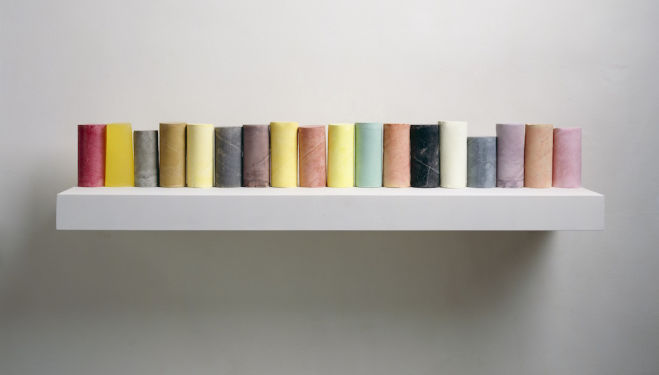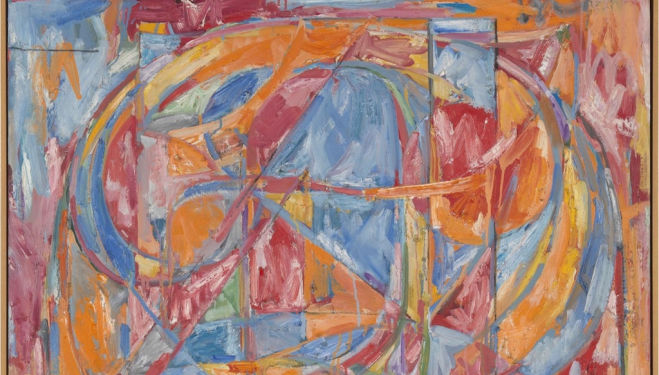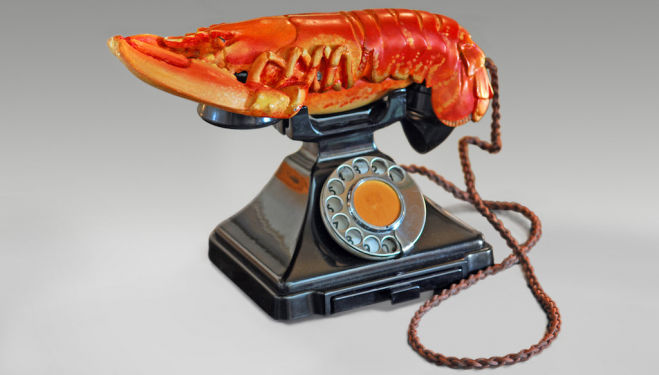
But scratch the surface, and Salvador Dalí and Marcel Duchamp have more in common than you might think. Or, so tries to prove The Royal Academy’s major autumn exhibition, Dalí / Duchamp. Taking their close friendship as a starting point, the exhibition traces the surprising links, from eroticism to chess, between the two. And despite a few silly comparisons, does so quite successfully.
Duchamp’s The King and Queen Surrounded by Swift Nudes, 1912 opens the exhibition. And what an opening it is. This grandiose Cubist-style painting, with its harsh geometric lines, rust colour palette and tripartite composition mesmerises, but it also encapsulates the themes – subversion and perversion, sex and, game playing – running through the exhibition. It's a clever introduction to a complex show.
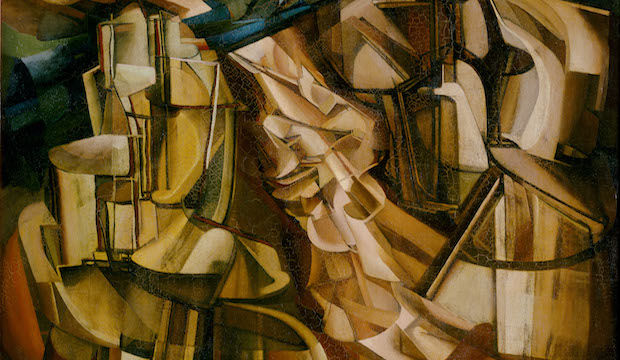
Marcel Duchamp, The King and Queen Surrounded by Swift Nudes (verso with Paradise: Adam and Eve), 1912. © Succession Marcel Duchamp/ADAGP, Paris and DACS, London 2017
Both Dali and Duchamp subverted expectations. Both wanted to provoke. But both did this in different ways. The rational, austere Duchamp challenged the status quo of what ' modern art' was with his ground-breaking 'readymades', while Dali, the self-promoting showman, unsettled the Surrealist mantra with his nightmarish and at times downright pornographic visuals. Their aesthetic vision may be polar-opposite, but their reprobate attitude was remarkably similar. In that respect, ' they were kindred spirits' says, co-curator Dawn Ades.
The central vitrine in Burlington House's second gallery presents a collection of their most outlandish but critically acclaimed pieces. Dali’s Lobster Telephone, nestles up to Duchamp’s early 'readymades' – aesthetically neutral object-sculptures that would become his tour de force – and, most importantly, to his ground-breaking urinal sculpture Fountain, 1917.
Fountain is at once troubling and confusing, and for most of us, nothing more than a bog standard white porcelain urinal. But in 2004, Fountain was voted the most influential work of the twentieth century. In presenting a pre-existing object as a work of art, Duchamp altered perceptions around creation; simply by selecting the object and presenting it as art, he asserted himself as the artist. This unusual attitude towards creation revolutionised popular opinion regarding 'art-making', making Duchamp one of the cerebral greats of the twentieth century.
Dali on the other hand was all about face-value shock. Masturbating men and women pop out from almost every one of his exhibited frames. His celebrated 1929 painting The First Days of Spring strikes the most perverse of chords. The composition foregrounds an ashen-faced man burying his head into a woman’s cleavage, who, incidentally, legs akimbo, wears a pink tie, evocative of a giant vulva. In the background, we see pink dildos and skimpily clad women. Teasing the viewer, Dali's work is a sexual feast.
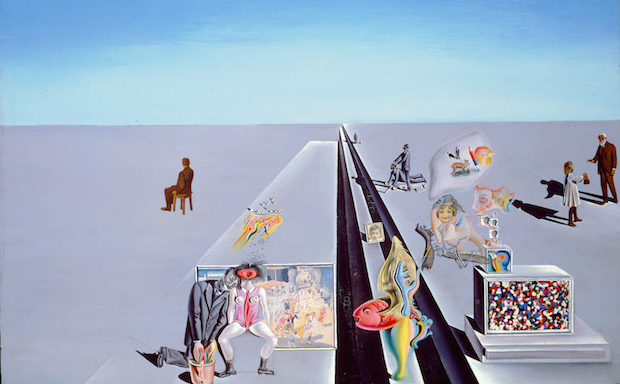
Salvador Dalí, The First Days of Spring, 1929. © Salvador Dali, Fundació Gala-Salvador Dalí, DACS 2017
What really binds these two men together is their sense of humour. Wit, laughter and game playing are at the very heart of both artists' practice and, thankfully, at the heart of the exhibition narrative too.
The final suite of rooms is dedicated to game playing. We see beautifully carved chess sets – Duchamp dedicated the latter years of his life to the strategic game – original black and white photographs of the Dali and Duchamp playing chess and an array of compositions with linguistic or visual puns at their core.
One such work is Duchamp's L.H.O.O.Q, 1919 – it is without a doubt one of the most amusing works in the exhibition. At the the bottom of the defaced postcard of Leonardo's Mona Lisa, Duchamp has added the letters L.H.O.O.Q. When read aloud in French, the titular pun sounds like ‘she has a hot ass’. While it’s a simple gag, it reveals Duchamp’s puerile prankster within. We soon see this cerebral Master in a playful new light.
Although the curators present plenty of evidence that Duchamp and Dali shared common interests and were good friends, it's not clear from the exhibition how their friendship influenced their work stylistically. Apart from Dali's contribution to Duchamp’s Etant donné – Dali was one of only three to know about and, in fact, contribute to Duchamp’s final masterpiece – there is no sign of any further artistic collaboration. Friends, yes, but artistic equals and collaborators, no.
Worlds apart in personality and style, this exhibition feels more like a retrospective in two parts. Yet thanks to the curators' decision to present Duchamp as far more than just a cerebral intellectual, and Dali as far more than a frivolous sex-obsessed reprobate, Dali/Duchamp casts a fresh, and joyous light on two of the most enigmatic provocateurs of the twentieth century. A commendable feat.
| What | Dalí/Duchamp exhibition review, Royal Academy |
| Where | Royal Academy, Burlington House, Piccadilly, London, W1J 0BD | MAP |
| Nearest tube | Green Park (underground) |
| When |
07 Oct 17 – 03 Jan 18, Fridays until 10pm |
| Price | £16.50, Concessions available |
| Website | Click here to read more via the Royal Academy |

